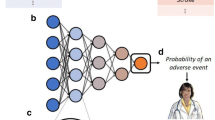Abstract
Purpose of Review
An understanding of the basics concepts of deep learning can be helpful in not only understanding the potential applications of this technique but also in critically reviewing literature in which neural networks are utilized for analysis and modeling.
Recent Findings
The term “deep learning” has been applied to a subset of machine learning that utilizes a “neural network” and is often used interchangeably with “artificial intelligence.” It has been increasingly utilized in healthcare for computational “learning”, especially for pattern recognition for diagnostic imaging. Another promising application is the potential for these neural networks to improve the accuracy in the identification of patients who are at risk for cardiovascular events and could benefit most from preventive treatment in comparison with more conventional statistical techniques. The importance of such tailored cardiovascular risk assessment and disease management in individual patients is far reaching given that cardiovascular disease is the leading cause of morbidity and mortality in the world. Nearly half of myocardial infarctions and strokes occur in patients who are not predicted to be at risk for cardiovascular events by current guideline-based approaches. Equally important are individuals who are not at risk for cardiovascular events and yet are given expensive and unnecessary preventive treatment with potential untoward side effects.
Summary
The application of powerful artificial intelligence/deep learning tools in medicine is likely to result in more effective and efficient health care delivery with the potential for significant cost savings by shifting preventative treatment from inappropriate to appropriate patient subgroups.


Similar content being viewed by others
References
Papers of particular interest, published recently, have been highlighted as: • Of importance •• Of major importance
Miller AS, Blott BH, Hames TK. Review of neural network applications in medical imaging and signal processing. Med Biol Eng Comput. 1992;30(5):449–64.
Forsström JJ, Dalton KJ. Artificial neural networks for decision support in clinical medicine. Ann Med. 1995;27(5):509–17.
Doi K. Computer-aided diagnosis in medical imaging: historical review, current status and future potential. Comput Med Imaging Graph. 2007;31(4–5):198–211.
Baxt WG. Use of an artificial neural network for the diagnosis of myocardial infarction. Ann Intern Med. 1991;115:843–8.
Lo SCB, Chan HP, Lin JS, Li H, Freedman MT, Mun SK. Artificial convolution neural network for medical image pattern recognition. Neural Netw. 1995;8(7/8):1201–14.
Cupples TE, Cunningham JE, Reynolds JC. Impact of computer-aided detection in a regional screening mammography program. Am J Roentgenol. 2005;185(4):944–50.
Luo G, Dong S, Wang K, Zuo W, Cao S, Zhang H. Multi-views fusion CNN for left ventricular volumes estimation on cardiac MR images. IEEE Trans Biomed Eng 2017
Betancur J, Commandeur F, Motlagh M, et al. Deep learning for prediction of obstructive disease from fast myocardial perfusion SPECT: a multicenter study. J Am Coll Cardiol Img. 2018;11(7):1000–9.
Shaw LJ. Can a machine learn better than humans? J Am Coll Cardiol Img. 2018;11(7):1010–1.
Burke HB, Rosen DB, Goodman PH. Comparing artificial neural networks to other statistical methods for medical outcome prediction. IEEE. 1994;7:2213–6.
•• Krittanawong C, Hong Ju Z, Wang Z, Ayadar M, Kitai T. Artificial intelligence in precision cardiovascular medicine. J Am Coll Cardiol. 2017;69(21):2657–64 This article provides an excellent overview of the potential for AI including supervised and unsupervised and deep learning in cardiovascular medicine including clinical implications and limitations.
•• Weng SF, Reps J, Kai J, Garibaldi JM, Qureshi N. Can machine-learning improve cardiovascular risk prediction using routine clinical data? PLoS One 2017; 12(4): e0174944; 1–14. This study demonstrates the superiority of machine learning algorithms in the prediction of a first cardiovascular event from routine clinical data in comparison to the established ACC algorithm, especially neural networks which performed best.
Ricker PM, Danielson E, Fonseca FAH, et al. Resuvastatin to prevent vascular events in men and women with elevated C-reactive protein. N Engl J Med. 2008;359(21):2195–207.
Mendel K, Li H, Sheth D, Giger M. Transfer learning from convolutional neural networks for computer-aided diagnosis: a comparison of digital breast tomosynthesis and full-field digital mammography. Acad Radiol 2018.
Tanner MA, Wong WH. The calculation of posterior distributions by data augmentation. J Am Stat Assoc. 1987;82(398):528–40.
Tafeit E, Reibnegger G. Artificial neural networks in laboratory medicine and medical outcome prediction. Clin Chem Lab Med. 1999;37(9):845–53.
Jahanifar M, Zamani Tajeddin N, Mohammadzadeh Asl B, Gooya A. Supervised saliency map driven segmentation of lesions in dermoscopic images. IEEE J Biomed Health Inform 2018.
Kamruzzaman SM, Jehad Sarkar AM. A new data mining scheme using artificial neural networks. Sensors (Basel). 2011;11(5):4622–47.
• Dilsizian SE, Siegel EL. Artificial intelligence in medicine and cardiac imaging: harnessing big data and advanced computing to provide personalized medical diagnosis and treatment. Curr Cardiol Rep. 2014;16(1):441 This paper provides an overview of the many challenges in the application of AI in cardiac imaging and medicine in general including workflow, medicolegal and regulatory as well as requirements for human curation and annotation.
Author information
Authors and Affiliations
Corresponding author
Ethics declarations
Conflict of Interest
The authors declare that they have no conflict of interest.
Human and Animal Rights and Informed Consent
This article does not contain any studies with human or animal subjects performed by any of the authors.
Additional information
This article is part of the Topical Collection on Nuclear Cardiology
Rights and permissions
About this article
Cite this article
Dilsizian, M.E., Siegel, E.L. Machine Meets Biology: a Primer on Artificial Intelligence in Cardiology and Cardiac Imaging. Curr Cardiol Rep 20, 139 (2018). https://doi.org/10.1007/s11886-018-1074-8
Published:
DOI: https://doi.org/10.1007/s11886-018-1074-8




